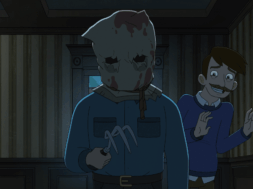
We revisit the first ever survival horror video game and examine how this humble NES title is still influencing the frightening genre.
“You must escape this house of residing evil.”
The survival horror genre has grown an impressive amount in the few decades that it’s been a part of gaming. The area has exploded from what started as one of the most niche of sub-genres to what is now one of most popular, celebrated variety of video games. When the merits of survival horror come up in conversation, people typically look back to the pioneers in the genre—your Resident Evils, Silent Hills, and your Alone in the Darks—with an appropriate amount of reverence. However, one of the most influential, essential games in the survival horror genre is, unfortunately, a title that many people in the public have never even heard about: Sweet Home. In fact, Sweet Home is a survivor horror game that existed before the term “survival horror” had even been coined and it would go on to influence practically every early survivor horror game that’s considered to be a classic.
One of the biggest surprises about Sweet Home is that it came out in 1989 and for the Famicom/NES, making it wildly ahead of its time. It’s considered to be the first official survival horror game and technically the first console horror RPG, too (it also technically qualifies as a sim, on some level). On top of that, the game is also inexplicably a movie tie-in and was even released on the same day that the film version of Sweet Home came out. A lot of the credit for Sweet Home’s unique, innovative design goes to the game’s director, Tokuro Fujiwara. Fujiwara even toured the film version of Sweet Home’s set to get inspiration for the game’s layout. It also didn’t hurt that famous Japanese horror director Juzo Itami was a producer on the game, too (and executive producer on the film). Fujiwara had previously primarily worked on arcade games and is perhaps most famously known for the 1985 version of Ghosts ‘n Goblins. He also did work on titles like Commando and Mega Man 2, but Sweet Home would largely be considered as his crowning achievement.
One of the major reasons that Sweet Home is such an underappreciated addition to the survival horror library is because it was only released on the Famicom and never saw an American release due to the title’s gruesome content. In spite of this, the game still has a strong reputation to this day and in the year 2000 a translation patch was even released (by Gaijin Productions, no less). Sweet Home received favorable reviews for the most part upon its release and many even thought that it was better than the film that it was based on, which is a rarity. Famitsu’s score for the title was an average 28/40, but still reasonably high for a survival horror game at that time. Sweet Home was appreciated during its release, but it’s appreciated even more now. Fans are so committed and have such love for this game that they’ve even slipped this translated ROM into actual Sweet Home cartridges so the experience can be as authentic as possible.
The game follows a very simple premise where a small team of five individuals enters Lady Mamiya’s mansion—a haunted house—in order to investigate what’s inside. It doesn’t take long for the supernatural entities that live in the mansion to begin to rebel. Sweet Home is very to the point, but this helps establish the genre and many other titles would use this framework in the future. Resident Evil and Alone in the Dark might borrow a lot from it, but it strangely feels even more similar to LucasArts’ Maniac Mansion from around the same period due to its character selection mechanic. Strangely enough, Sweet Home also really feels like a horror-themed version of the original Phantasy Star and who doesn’t want that? It’s also easy to see it as a precursor to early Metroidvania-esque games due to its labyrinthine mansion (the game even came included with a large fold-out map).
More than anything Sweet Home looks like an NES version of Resident Evil and there’s a lot more than the basic premise that the one Capcom title owes to the other. Sweet Home features slow, ominous loading screens when doors are opened, just like in Resident Evil and it also contains a very similarly frustrating inventory system. Sweet Home is also one of the first games to use scattered notes, diaries, and log entries to tell a story, which is not only still done to this day, but basically seen as the standard. None of this should exactly come as a surprise because Resident Evil was even originally planned to be a Sweet Home remake! Fujiwara is even a producer on the game. In the end, Resident Evil would differ enough to become its own entity. That being said, there’s a particularly creepy scene where players must walk through a hallway as dogs jump out and attack them that clearly Resident Evil wanted to “borrow.” Plus, Resident Evil 0 would still borrow from Sweet Home decades later, like with its instantaneous character swapping system. Sweet Home also literally uses the line “You must escape this house of residing evil,” which is pretty damn funny in retrospect. Clearly these games are in conversation with one another.
Another impressive dimension of Sweet Home is that it also incorporates RPG elements where gamers must pick who they want to be on their team and then take them to explore the Mamiya mansion. Interestingly enough, Sweet Home will let players embark on this mission on their own, but they’re destined to almost immediately die if they make this decision because the enemies are too strong to fight on your own. Sweet Home is happy to let its players make mistakes, which also feels like a staple of later survival horror titles where poor decisions do have consequences. Additionally, each character that players choose have specific skills, like how Kazuo has a lighter, Emi can unlock doors, Taro can take pictures. Plus, if any of these characters die, they’re dead for good (think early Fire Emblem). There’s no bringing them back and how many members of your team that are still alive at the end of the game will affect Sweet Home’s conclusion.
Sweet Home’s battles follow a very RPG-style structure and characters can gain experience, level up, and gain stronger weapons with better stats as they proceed through the mansion. Players also have two parties that they manage at once. You’re meant to have your parties ultimately work together as one big team, but this division makes aspects like item management super important in the game. Sweet Home also tells its players shockingly little about what they need to do and it leaves much of the puzzle solving to the gamer. This proves to be an exceptional challenge, even with a guide, that’s it a wonder to think that people genuinely completed it back in ’89. At least there’s some really awesome music (and an particularly badass, gothic battle theme) to entertain players through this troubleshooting.
There are all sorts of traps and elements that are faulty in Mamiya mansion (like limited health items or bridges that break after a set amount of steps are taken on them) that players need to figure out about the hard way or otherwise they’ll just be stuck in the game. Fire is used to burn down barriers, mallets can knock down obstacles, boots are used to get across goo without getting stuck, a pick help players not slip on ice. There’s also a crazy degree of meticulousness to the title like where players need to take a plank of wood because it will later be used to fill in gaps and cross chasms, but if the plank isn’t retrieved afterwards, then you’ll get stuck. Gamers also need to earn enough Pray Points through battle in order to gain access to certain areas, which is thankfully not a concept that carried over into Resident Evil.
There are other innovative ideas present here like how enemies such as Worms are extra vulnerable to items like lighters or that bats are weak to a camera flash. Every enemy has some sort of item-based weakness and even if that’s Capcom’s Mega Man tendencies shining through the game, it’s still a nice touch! There are even rudimentary quick time events where poltergeisted furniture will fling itself at players unless they push the right button in time to avoid the attack! Sweet Home also impressively features a number of different endings that are triggered based on how well players do. All of this is very impressive and shows great foresight for a Nintendo title.
Ultimately Sweet Home might not be scary, but very few games from 1989 actually are. That being said, Sweet Home is about as scary as a Nintendo game can be, but this is a title that’s more important for its innovation, what it inspired, and what other titles would borrow from its creepy nature, not how frightening it is. Even still, there are certain enemies like Evil Doll and Grave (a vomiting zombie) that do stand out. The death screen, where a body rots away into a skeleton and then decomposes further into pieces of flesh is also fairly grotesque. There are also impressive lightning effects, which add a lot of character and atmosphere to the experience. Furthermore, background assets like the bones in a graveyard or creepy statues really stick out, too. The final battle that takes place before the final boss, Lady Mamiya, involves gamers fighting doppleganger versions of their team, which is actually quite disturbing.
Sweet Home remains to be one of the most interesting, overlooked titles in the history of survival horror. It’s certainly encouraging to see the niche title’s popularity increase through the years, but it’s fair to say that more obscure series with less impact like Clock Tower or Parasite Eve are still better known. Unfortunately Sweet Home’s translated version hasn’t made its way over to any of Nintendo’s various Virtual Consoles or online services (not even in Japan), but it’s worth the extra effort to seek out and play for those that are interested (the film isn’t that bad of a watch either). Who knows, with remakes of older titles still very much in fashion, maybe a fully overhauled true remake of Sweet Home will eventually find itself on the Switch.
Modern gamers need to figure out just what the hell a fresco is!














